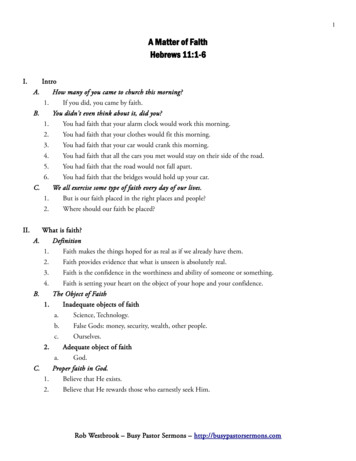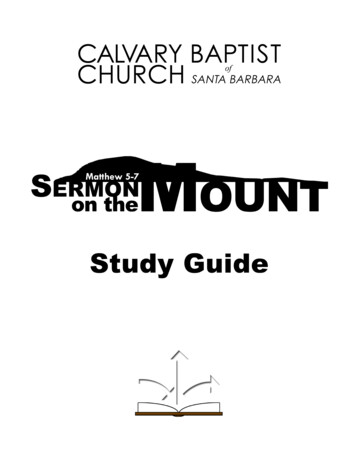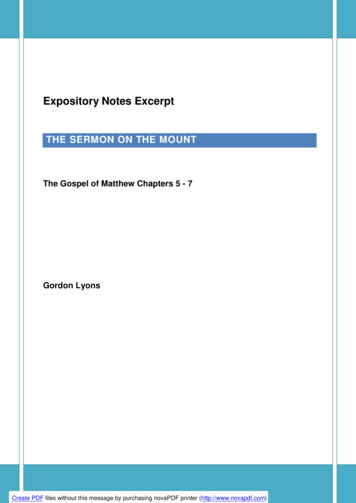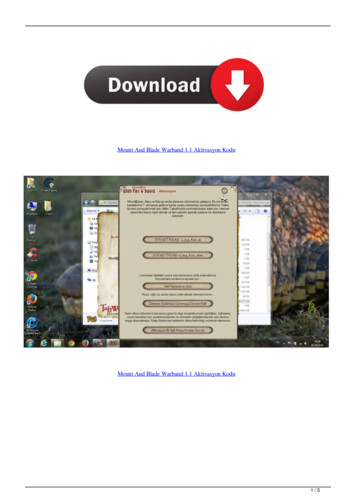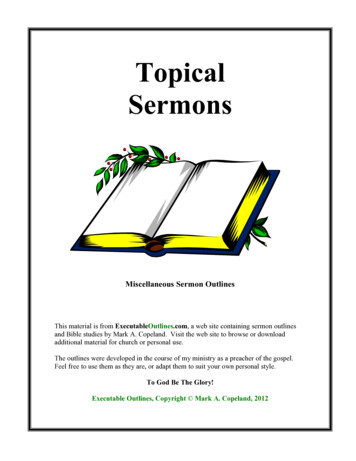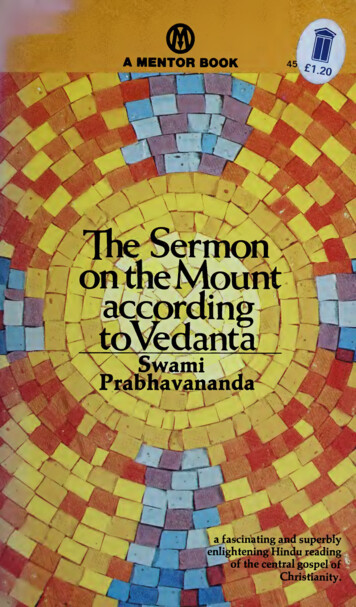
Transcription
\" 'y\A MENTOR BOOK1,wami \«ram A a fascinating
Digitized by the Internet Archivein 2017 with funding /sermononmountaccOOprab
66Like Krishna and Buddha, Christ didnot preach a mere ethical or social gos pel hut an uncompromisingly spiritualone. He declared that God can be seen,that divine perfection can be achieved.In order that men might attain this su preme goal of existence, he taught therenunciation of worldliness, the con templation of God, and the purificationof the heart through the love of God.These simpleand profound truths,stated repeatedly in the Sermon on theMount, constitute its underlying theme9as I shall try to show in the pages tofollowr—from the Introduction bySwami PrabhavanandaTHE SERMON ON THE MOUNTaccording toVEDANTA
Other MENTOR Titles of Related Interest SHAN KARA'S CREST-JEWEL OF DISCRIMINA TION translated by Swami Prabhavananda andChristopher Ssherwood. The philosophy of thegreat Indian philosopher and saint, Shankara. Itsimplications for the man of today are sought outin the Introduction,(#MY1054— 1.25) THE SONG OF GOD: RHAGAVAD-GITA translatedby Swami Prabhavananda and Christopher Isherwood. A distinguished translation of the Gospelof Hinduism, one of the great religious classics ofthe world. Introduction by Aldous Huxley. Appen dices.(#MY1425— 1.25) THE UPAN5SHAD8: BREATH OF THE ETERNALtranslated by Swam! Prabhavananda and Freder ick Manchester. Here is the wisdom of the Hindumystics in principal texts selected and translatedfrom the original Sanskrit.(#MY1424— 1.25) HOW TO KNOW GOD: THE YOGA APHORISMSOF PATANJALI translated with Commentary bySwami Prabhavananda and Christopher Isherwood. This classic work on yoga, its goal andmethods, is essential to an understanding ofHindu religious practice. For more than fifteenhundred years the writings of Patanjali have beena principle influence on Hindu spiritual exercises.Index.(#MY1382— 1.25)THE NEW AMERICAN LIBRARY, INC.,P.O. Box 999, Bergenfield, New Jersey 07621Please send me the MENTOR BOOKS I have checked above.I am enclosing -(check or money order—nocurrency or C.O.D.’s). Please include the list price plus 25 acopy to cover handling and mailing costs. (Prices and numbersare subject to change without notice.)Name.Address —City-State Zip CodeAllow at least 3 weeks for delivery
The Sermonon the Mountaccording toVedantaby Swami Prabhavananda A MENTOR BOOK from,NEW AMEmCAiM LIBRARYtimes svunnor?New York and Scarborough, OntarioThe New English Library Limited. London
Copyright 1963 by Vedanta Society of SouthernCaliforniaAll rights in this book are reserved. No part of the book may bereproduced in any manner whatsoever without writtenpermission except in the case of brief quotations embodied incritical articles and reviews. For information addressVedanta Press, 1946 Vedanta Place,Hollywood, California 90068.Library of Congress Catalog Card Number: 64-8660Published by arrangement with The Vedanta Society ofSouthern California. MENTOR TRADEMARK REG. U.S. PAT. OFF. AND FOREIGN COUNTRIESREGISTERED TRADEMARK-MAROA REGISTRADAHEOHO EN CHICAGO, U.3.A.Signet, Signet Classics, Mentor, Plume and Meridian Booksare published in the United States byThe New American Library, Inc.,1301 Avenue of the Americas, New York, New York 10019,in Canada by The New American Library of Canada Limited,81 Mack Avenue, Scarborough, 704, Ontario,in the United Kingdom by The New English Library Limited,Barnard’s Inn, Holbom, London, E.C. 1, England.First Mentor Printing, July, 197223456789 101iPRINTED in THE UNITED STATES OF AMERICAThose who wish to learn in greater detail about the teachingscontained in this book are advised to communicate with theSecretary, The Vedanta Society of Southern California,1946 Vedanta Piace, Hollywood, California 90068.
ForewordA book on the Sermon on the Mount, which is thevery heart of the Christian teaching, should be no nov elty in a Christian community. But when that book iswritten by a Hindu Swami, a follower of Vedanta andthe Gospel of Sri Ramakrishna, a book, moreover, notonly interpreting, but extolling the Sermon as though itwere a scripture of his own, that certainly is, to say theleast, unusual.Beautiful as this interpretation is in itself, it is pre sented by Swami Prabhavananda not as a far-off, scarce ly attainable ideal, which is the way most occidentalsread the Sermon, but as a practical program of dailyliving and conduct. So clear is the Swami’s reading ofthis great scripture, that many a Christian by means ofit will discover a simpler approach to the teaching of hisMaster, more direct than any he had found heretofore.Vedanta teaches that man’s real nature is divineand that the chief, the only real goal of human life is tounfold and manifest that divinity. To us the Sermon isa counsel of perfection. To the Vedantist, whose soleaim is God-realization, that is nothing strange. Thesannyasin of the Ramakrishna Order, to which SwamiPrabhavananda belongs, follows the way of perfectionevery day of his life. Every day in his meditation heprays that he may overcome the sense of ego, that hemay abstain from fault-finding and criticism of others,and that he may acquire love and sympathy for all. TheVedantist cannot sit down to meditate until he clears hismind of all hatreds and resentments. The literature ofthe Ramakrishna Order, as for instance the Gospel ofv
viThe Sermon on the Mount according to VedantaSri Ramakrishna, the writings of Swami Vivekananda,and that priceless little book by Swami Prabhavananda,The Eternal Companion, all are filled with teachingssimilar to those of the Sermon and other parts of ourBible.In the book of Exodus we read that when Mosescame down from the mount, “Moses wist not that theskin of his face shone.” Swami Prabhavananda in thisvolume tells of seeing one of his elders, a direct discipleof Sri Ramakrishna, so transfigured. A light emanatedfrom his whole body. Not only did Swami Prabhavan anda see it, but crowds of people in a temple lane whereit occurred, fell back in amazement and made way as theillumined holy man walked in complete absorption inthe thought of God.Phenomena of that order are not confined to scrip tures dating hundreds and thousands of years back. Theycan and do occur today. Religion is a continuing fact inhuman life. The prescriptions of the Sermon on theMount can be and are lived today. It depends upon thespirit in which they are accepted. Swami Prabhavanandaand his fellow-Vedantists accept them realistically. Thatis probably the reason that people of various creeds andChristian sects, who come to the lectures on Vedanta,often find that their own creed appears suddenly brighterand more luminous, and their understanding of it at tains a deeper penetration.Vedanta, briefly, comes to the West not to supplantany religion, but to bring a more tangible spirituality tothose who seek it. Its goal is not to proselytize, but tohelp man realize the divinity within him. In that itclaims, not without reason, to be the most practical ofreligious philosophies. And that practicality is whatSwami Prabhavananda successfully conveys in his re markably fine and lucid interpretation of the Sermonon the Mount.Henry James Forman
AcknowledgmentsAcknowledgments are due to a number of pub lishers for permission to reprint selections from theirbooks: to Advaita Ashrama, Mayavati, India, for pas sages from The Complete Works of Swami Vivekananda; to Methuen & Company, Ltd., London, for a passagefrom The Confessions of Jacob Boehme, compiled andedited by W. Scott Palmer; to Harper & Row, Publishers,Inc., for passages from The Way of a Pilgrim and ThePilgrim Continues His Way, translated from the Russianby R. M. French; and to the Vedanta Society of SouthernCalifornia for passages from the following works: Howto Know God, the Yoga Aphorisms of Patanjali, trans lated with a new commentary by Swami Prabhavanandaand Christopher Isherwood; The Song of God: Bhagavad-Gita, translated by Prabhavananda and Isher wood; The Upanishads, translated by Prabhavanandaand Frederick Manchester; The Wisdom of God(Srimad Bhagavatam), translated by Prabhavananda.Selections from Sri Ramakrishna’s life and teach ings are principally from Sri Sri Ramakrishna Lilaprasanga, by Swami Saradananda, and Sri Sri Rama krishna Kathamrita, by M.The lectures upon which this book is based weregiven by the author at the Hollywood and Santa Bar bara temples of the Vedanta Society of Southern Cali fornia. Some portions of the material have appeared inthe magazine Vedanta and the West and in an anthology,Vedanta for the Western World, edited by ChristopherIsherwood.I would like to thank Henry James Forman forwriting the Foreword. I am indebted to Pravrajika Anandaprana for editing the manuscript and giving thebook its present form, and to Benjamin Saltman foreditorial assistance.—S. P.VI i
ContentsFOREWORD by Henry James FormanINTRODUCTIONvxiCHAPTERThe Beatitudes17The Salt of the Earth36IHResist Not Evil59IVBe Ye Therefore Perfect69VThe Lord’s Prayer84VIGod and Mammon99VIIStrait Is the GateIII112
This book is based on lectures I have given on theSermon on the Mount. The lectures have been revisedand expanded to cover teachings not previously com mented upon. To me, the Sermon on the Mount repre sents the essence of Christ’s gospel; and it is printed herein its entirety, as it is set down, so that Christ’s wordsmay be read in sequence and the unity of his messagemay be clearly seen.I am not a Christian, I am not a theologian, I havenot read the Bible interpretations of the great Christianscholars. I have studied the New Testament as I havestudied the scriptures of my own religion, Vedanta. Ve danta, which evolved from the Vedas, the most ancientof Hindu scriptures, teaches that all religions are trueinasmuch as they lead to one and the same goal—Godrealization. My religion therefore accepts and reveresall the great prophets, spiritual teachers, and aspects ofthe Godhead worshiped in different faiths, consideringthem to be manifestations of one underlying truth.As a young monk, I dwelt in close association withmost of the monastic disciples of Sri Ramakrishna, thefounder of the order to which I belong. These holy menlived in the consciousness of God and taught us themethods by which one may reach the ultimate andblessed state of mystic union—samadhi, as it is calledin Vedanta. From what I have seen in these holy men,and from whatever understanding I have gained sittingat their feet, I have tried to approach the teachings ofChrist. This is why I have often turned to the wordsof Sri Ramakrishna and his disciples to help explain thetruths of the Sermon on the Mount.xi
xiiThe Sermon on the Mount according to VedantaOne of these disciples of Sri Ramakrishna was mymaster, Swami Brahmananda. Although he was not astudent of the Bible, from his own spiritual experiencehe taught in much the same way as Christ did, and oftenused almost the same words. My master had seen Christin spiritual vision, and celebrated Christmas every yearby offering special worship to Jesus, a custom which hasbeen observed in all the monasteries of the RamakrishnaOrder to the present day. On these occasions fruit, bread,and cake are offered in our Hindu way. Often there isa lecture on Christ; or the story of the Nativity or theSermon on the Mount is read.One of these Christmas celebrations, the first I everattended, had great bearing on what Christ means to me.It took place in 1914 at Belur Math near Calcutta, wherethe headquarters of our order are situated. I had joinedthe monastery just a few days before. On Christmas Eve,we gathered before an altar on which a picture of theMadonna and Child had been placed. One of the seniormonks performed worship with offerings of flowers, in cense, and food. Many of Sri Ramakrishna’s disciplesattended the service, among them my master, who wasthe president of our order. While we were seated insilence, my master said: “Meditate on Christ within,and feel his living presence.” An intense spiritual atmo sphere pervaded the worship hall. Our minds were liftedup, and we felt ourselves transported into another con sciousness. For the first time I realized that Christ wasas much our own as Krishna, Buddha, and other greatillumined teachers whom we revered. As a Hindu, I wastaught from childhood to respect all religious ideals, torecognize the same divine inspiration in all the differentfaiths. Thus Christ as a manifest expression of divinityI could never have considered foreign. But for a livingand personal experience of him I needed the tangibleheightening of consciousness resulting from the worshipon that memorable Christmas Eve.
Introduction xmAn intimate spiritual connection between Christ andmy monastic order has existed for many years, begin ning with its founder, Sri Ramakrishna, who was ac corded divine worship during his lifetime and since hispassing away in 1886 has received growing recognitionin India as an incarnation of God. Of the many greatsaints and illumined teachers in the history of Vedanta,Sri Ramakrishna expressed in his life to a greater de gree than any other teacher the idea of religious uni versality and harmony. Not only did he undergo the dis ciplines of divergent sects within Hinduism but those ofMohammedanism and Christianity as well. Througheach religious path he achieved the supreme realizationof God, and thus was able to proclaim with the authorityof direct experience: “So many religions, so many pathsto reach one and the same goal.”It was about 1874 that Sri Ramakrishna interestedhimself actively in Christianity. A devotee who used tovisit the Master at the Dakshineswar temple garden nearCalcutta would explain the Bible to him in Bengali.One day, while Sri Ramakrishna was seated in the draw ing room of another devotee’s home, he saw a pictureof the Madonna and Child. Absorbed in contemplationof this picture, he saw it suddenly become living andeffulgent. An ecstatic love for Christ filled Sri Ramakrishna’s heart, and a vision came to him of a Christianchurch in which devotees were burning incense and light ing candles before Jesus. For three days Sri Rama krishna lived under the spell of this experience. On thefourth day, while he was walking in a grove at Dak shineswar, he saw a person of serene countenance ap proaching with his gaze fixed on him. From the inmostrecesses of Sri Ramakrishna’s heart came the realization,“This is Jesus, who poured out his heart’s blood for theredemption of mankind. This is none other than Christ,the embodiment of love.” The Son of Man then em braced Sri Ramakrishna and entered into him, and Sri
xivThe Sermon on the Mount according to VedantaRamakrishna went into samadhi, the state of transcen dental consciousness. Thus was Sri Ramakrishna con vinced of Christ’s divinity.Shortly after Sri Ramakrishna’s death, nine of hisyoung disciples gathered on a winter night before asacred fire to take their vows of formal renunciation—henceforth they were to serve God as monks. Theirleader, the future Swami Vivekananda, told his brothersthe story of Jesus’ life, asking them to become Christsthemselves, to pledge themselves to aid in the redemp tion of the world, and to deny themselves as Jesus haddone. Later, the monks discovered that this evening hadbeen the Christian Christmas Eve—a very propitiousoccasion for their vows.Thus, since the early days of our order, Christ hasbeen honored and revered by our Swamis as one of thegreatest of illumined teachers. Many of our monks quoteChrist’s words to explain and illustrate spiritual truths,perceiving an essential unity between his message andthe message of our Hindu seers and sages. Like Krishnaand Buddha, Christ did not preach a mere ethical orsocial gospel but an uncompromisingly spiritual one.He declared that God can be seen, that divine perfec tion can be achieved. In order that men might attainthis supreme goal of existence, he taught the renuncia tion of worldliness, the contemplation of God, and thepurification of the heart through the love of God. Thesesimple and profound truths, stated repeatedly in theSermon on the Mount, constitute its underlying theme,as I shall try to show in the pages to follow.July 1963Swami Probhavananda
The Sermonon the Mountaccording toVedanta
Chapter IThe BeatitudesMatthew 5:1-12Before the time came for Jesus to give his Sermon onthe Mount, he traveled all over Galilee preaching. “Andhis fame went throughout all Syria,” as St. Matthewsaid. The news spread of an extraordinary teacher, andcrowds gathered to see him—as they have done forthousands of years in the Orient and still do at the ap proach of a God-man. They journeyed “from Galilee,and from Decapolis, and from Jerusalem, and fromJudaea, and from beyond Jordan.” And Jesus taughtthe multitude according to its capacity; but his Sermon,which contains his highest teachings, he reserved forhis disciples, for the ones who were spiritually ready.He took them to a hillside where they would not beinterrupted by those who wanted less than his supremetruth.And seeing the multitudes, he went up into a moun tain: and when he was set, his disciples came unto him:And he opened his mouth, and taught them, say ing,.17
18The Sermon on the Mount according to VedantaEvery spiritual teacher, whether he is a divine incar nation or an illumined soul, has two sets of teachings—one for the multitude, the other for his disciples. Theelephant has two sets of teeth: the tusks with which hedefends himself from external difficulties and the teethwith which he eats. The spiritual teacher prepares theway for his message with broad lessons-—with his tusks,as it were. The inner truth of religion he reveals only tohis intimate disciples. For religion is something whichcan actually be transmitted. A truly illumined teachercan transmit to us the power which unfolds the divineconsciousness latent within us. But the field must befertile and the soil ready before the seed can be sown.When crowds came on Sundays to visit Sri Ramakrishna, the most widely revered mystic of modemIndia, he would speak to them in a general way whichbenefited them. But when his intimate disciples gath ered around him, as I was told by one of them, hewould make sure that he was not overheard while giv ing them the sacred truths of religion. Not that thetruths themselves are secret—they are recorded, andanyone can read them. But what he gave to these dis ciples was more than verbal teachings. In a divine moodhe would uplift their consciousness.Christ taught in the same way. He did not give theSermon on the Mount to the multitude, but to his dis ciples, whose hearts were prepared to receive it. Themultitude is not yet able to understand the truth ofGod. It does not really want it. My master, SwamiBrahmananda, used to say: “How many are ready?Yes, many people come to us. We have the treasure togive them. But they only want potatoes, onions andeggplants!”Any one of us who sincerely wants the treasure, whoseeks the truth, can benefit from the message given in
The Beatitudes19the Sermon on the Mount and can become a disciple.Christ, as we shall see in our study of his Sermon,speaks of the conditions of discipleship which we mustfulfill—for which we must prepare ourselves. He teachesthe ways and means to attain to the purification of ourhearts, so that the truth of God may be fully revealedwithin us.Blessed are the poor m spirit: for theirs is thekingdom of heaven.In this first beatitude, Christ speaks of the chief char acteristic which the disciple must have before he isready to accept what the illumined teacher has to offerhim. He must be poor in spirit; in other words, he mustbe humble. If a man has pride in learning, wealth, beau ty, or lineage, or has preconceived ideas of what spiri tual life is and how he should be taught, his mind is notreceptive to higher teachings. In the Bhagavad-Gita, theGospel of the Hindus, we read: “Those illumined soulswho have realized the Truth will instruct you in theknowledge of Brahman [the transcendent aspect of God]if you will prostrate yourself before them, questionthem, and serve them as a disciple.”According to an Indian tale, a man came to a teacherand asked to*be made a disciple. The teacher, with hisspiritual insight, realized that the man was not readyto be taught. So he inquired: “Do you know what youhave to do in order to be a disciple?” The man said hedid not, and asked the teacher to tell him. “Well,” saidthe teacher, “you have to fetch water, gather fuel,cook, and do many hours of heavy work. You alsohave to study. Are you willing to do all that?”The man said: “Now I know what the disciple hasto do. Tell me please, what does the teacher do?”
20The Sermon on the Mount according to Vedanta“Oh, the teacher sits and gives spiritual instructionsin his quiet way.”“Ah, I see!” said the man. “In that case I don’t wantto be a disciple. Why don’t you make me a teacher?”We all want to be teachers. But before we becometeachers we must learn to be disciples. We must learn tobe humble.Blessed are they that mourn: for they shall be com forted.As long as we think that we are rich in worldly goodsor in knowledge, we cannot make spiritual progress.When we feel that we are poor in spirit, when we grievethat we have not realized the truth of God, then onlywill we be comforted. No doubt we all mourn—but forwhat? For the loss of worldly pleasures and posses sions. But that is not the kind of mourning of whichChrist speaks. The mourning which Christ calls“blessed” is very rare, because it arises from a sense ofspiritual loss, spiritual loneliness. It is a mourning whichnecessarily comes before God comforts us. Most of usare quite satisfied with the surface life we are leading.In the back of our minds perhaps we are aware that welack something, but still we cling to the hope that thislack can be filled by the sense objects of this world.Sri Ramakrishna used to say: “People weep riversof tears because a son is not born or because they can not get riches. But who sheds even one teardrop becausehe has not seen God?” This false sense of values is theresult of our ignorance. Regarding the nature of thisignorance, the Indian philosopher Shankara said thatthe subject, the knower (Self, or Spirit), is as opposedto the object, the known (non-Self, or matter), as lightis opposed to darkness. Yet through the influence of
The Beatitudes21maya, the inexplicable power of ignorance, the subjectand object have become mixed, so that man habituallyidentifies the Self with the non-Self. It is very easy tounderstand intellectually that the true Self is differentfrom the body, just as we are different from the clotheswe wear. Yet when the body is diseased, we say: “I amsick.” Intellectually we can understand that the trueSelf is different from the mind. Yet when a wave of hap piness or suffering arises, we say: “I am happy,” or “Iam miserable.” Also, we identify ourselves with ourrelatives and friends: anything happening to them seemsto be happening to us. We identify ourselves with ourpossessions. If we lose our wealth, we feel as if we hadlost ourselves. This ignorance is common to all man kind. It can only be removed by the direct knowledgeof God. When we begin to mourn as Christ wished usto mourn, when we shed even one tear for God, thenwe prepare the way for the comfort of that divineknowledge.The kind of mourning that Christ called blessed is ex pressed in the Imitation of Christ: “O Lord God, whenshall I be made one with thee and be molten into thylove, so that I wholly forget myself? Be thou in me,and I in thee; and grant that we may so abide, alwaystogether in one.” We must come to this stage, whenwe feel that nothing can give us peace except the visionof God. Then God draws man’s mind to himself as amagnet draws a needle, and comfort comes.Blessed are the meek: for they shall inherit the earth.Ignorance and delusion are characteristic of the unre generate mind. This ignorance is confirmed and but tressed by our sense of ego—our idea that we are sep arate from one another and from God. Egotism must
22The Sermon on the Mount according to Vedantabe overcome if the mind is to be freed from delusion.Therefore—blessed are the meek. But why does Christsay that they shall inherit the earth? At first sight, thisseems difficult to understand. Among the yoga apho risms of Patanjali (yoga means union with God, alsothe path to that union) there is one aphorism whichcorresponds to this beatitude: “The man who is con firmed in non-stealing becomes the master of all riches.”What is meant by “non-stealing”? It means that wemust give up the egotistic delusion that we can possessthings, that anything can belong exclusively to us asindividuals. We may think: “But we are good people.We do not steal anything! Whatever we have, we haveworked for and earned. It belongs to us by right.” Butthe truth is that nothing at all belongs to us. Everythingbelongs to God. When we regard anything in this uni verse as ours, we are appropriating God’s possession.What then is meekness? It is to five in self-surrenderto God, free from the sense of “me” and “mine.” Thisdoes not mean that we should get rid of wealth, family,and friends; but we should get rid of the idea that theybelong to us. They belong to God. We should think ofourselves as God’s servants to whose care he has en trusted his creatures and possessions. As soon as weunderstand this truth and give up our deluded individualclaims, we find that in the truest sense everything be longs to us after all.Conquerors who try to become masters of the worldby force of arms never inherit anything except worry,trouble, and headaches. Misers who accumulate hugewealth are only chained to their gold, they never reallypossess it. But the man who has given up his sense ofattachment experiences the advantages which pos sessions afford without the misery which possessivenessbrings.
The Beatitudes23Many people dislike this saying of Christ becausethey think that the meek can never achieve anything.They think that no happiness is to be had in life unlessone is aggressive. When they are told to give up theego, to be meek, they are afraid that they will loseeverything. But they are wrong. In the words of SwamiBrahmananda: “People who live in the senses thinkthat they are enjoying life. What do they know aboutenjoyment? Only those who are filled with divine blissreally enjoy life.” But arguments will not prove thistruth. You have to experience it; then only will you beconvinced.If a spiritual aspirant sincerely follows Christ’s teach ing of meekness, he will find it very practical. He willfind that anger and resentment can be conquered bygentleness and love. The Chinese mystic Lao Tzu ex pressed this truth by saying: “Of the soft and weakthings in the world, none is weaker than water. But inovercoming that which is firm and strong, nothing canequal it. That which is soft conquers the hard. Rigidityand hardness are companions of death. Softness andtenderness are companions of life.” By sincerely givingup the ego to God, by being meek, we will gain every thing. We will inherit the earth.Blessed are they which do hunger and thirst afterrighteousness: for they shall be filled.What is the righteousness for which Christ wants usto hunger and thirst? It is the righteousness which in anumber of passages in the Old Testament is practicallysynonymous with salvation—in other words, with de liverance from evil, and union with God. This righteous ness therefore is not what we ordinarily think of asmoral virtues or good qualities, not relative good as
24The Sermon on the Mount according to Vedantaopposed to evil or relative virtue as opposed to vice,but absolute righteousness, absolute goodness. Thehunger and thirst after the righteousness of which Christspeaks is a hunger and thirst after God himself.It has already been pointed out that most of us donot really want God. If we analyze ourselves, we shallfind that our interest in God is not nearly as strong asour interest in all kinds of worldly objects. But even aslight desire to know the divine Reality is a beginningthat can lead us higher. We must start with self-effort.We must struggle to develop love for the Lord by prac ticing recollectedness of him, by prayer, worship, andmeditation. As we practice these spiritual disciplines,our slight desire to realize him will become intensifieduntil it is a raging hunger and a burning thirst.To those who asked him how to realize God, SriRamakrishna would say: “Cry to him with a yearningheart, and then you will see him. After the rosy light ofdawn out comes the sun; likewise, longing is followedby the vision of God. He will reveal himself to you ifyou love him with the combined force of these threeattachments: the attachment of a miser to his wealth,that of a mother to her new-born child, and that of achaste wife to her husband. Intense longing is the surestway to God-vision.”We must learn to direct all our thoughts and all ourenergy consciously toward God. One gigantic thoughtwave must be raised in the mind, engulfing all thecravings and passions which distract us from the spiri tual goal. When the mind thus becomes one-pointedand concentrated upon God, we shall be filled withrighteousness.There is a story of a disciple who asked his teacher,“Sir, how can I realize God?”“Come along,” said the teacher, “I will show you.”
The Beatitudes25He took the disciple to a lake, and both stepped in.Suddenly the teacher reached over and pressed thedisciple’s head under water. A few moments later hereleased him and asked: “Well, how did you feel?”“Oh, I was dying for a breath of air!” gasped thedisciple.Then the teacher said: “When you feel that intenselyfor God, you won’t have to wait long for his vision.”Blessed are the merciful: for they shall obtain mercy.One of the yoga aphorisms of Patan
A book on the Sermon on the Mount, which is the very heart of the Christian teaching, should be no nov elty in a Christian community. But when that book is written by a Hindu Swami, a follower of Vedanta and the Gospel of Sri Ramakrishna, a book, moreover, not only interpretin


